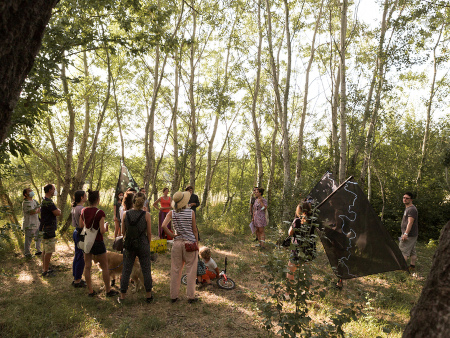A nature-based solution arising from a blending of art and science. This is the goal of a work, described in the journal Scientific Reports and presented by scientists from the National Research Council’s Institute for Terrestrial Ecosystems Research (CNR-IRET), with artist Andrea Conte. The result was Aula Verde, a land-art work that provides a space for socialization Emphasizing the value of trees and nature while providing a gathering space surrounded by greenery. These are some of the main goals of Green Classrooms, scientific-artistic realizations rising within public parks. Describing the groundbreaking project in an article in the journal Scientific Reports are scientists from the National Research Council’s Institute for Research on Terrestrial Ecosystems (CNR-IRET). The first Aula Verde is the result of a collaboration between IRET forest ecology experts and visual artist Andrea Conte (AndreCo).
The result, a land-art work inspired by nature, rises in Rome at the Villa dell’Aniene Nature Reserve. The Nature-Based Solution aims to offer all citizens an alternative space for socializing. Located within the public park, the area is in fact freely accessible. Created in collaboration with the Insieme per l’Aniene association and a group of citizens – it is part of the citizen science project “Flumen – Climate Art Project,” and consists of concentric circles of trees arranged in such a way as to give the impression of being inside a room entirely immersed in nature. “The tree species were selected on the basis of the ecological conditions of the site and to contribute to local environmental criticalities,” explains Laura Passatore, a CNR-Iret researcher and coordinator of the study. “These are, in fact, willows and white poplars, plants capable of moving very significant volumes of water. Positioned near the banks of the urban section of the Aniene River, they have the potential to dispose of flood water from heavy rains,” the scientist continues.
Using specific software, the ecosystem services resulting from the work were measured: it was estimated that, at maturity, the trees in the “Green Classroom” will be able to intercept and return 48,000 liters of rainwater per year to the atmosphere, and that over the next fifty years they will be able to absorb up to 48 tons of carbon and 11 kilograms of air pollutants, including ozone, nitrogen dioxide and PM10. In addition to reminding us of the value of trees in combating the climate crisis and for the well-being of humans and ecosystems, the study also highlights the value of the initiative’s participatory and multidisciplinary approach, combining concepts of ecology and urban forestry with political ecology, humanities and regenerative art. “Aula Verde is an artistic and social reforestation method that stems from the desire to find collective actions for climate justice and the need to experiment with ecocentric design approaches as a response to anthropocentrism,” continues Andrea Conte (Andreco), visual artist and environmental engineer, founding partner of Futurecologies and Climate Art Project. “We have created a bridge between art, science and political ecology, seemingly distant disciplines, to address the complexity of contemporary urgencies and better rethink the urban spaces in which we live. The inclusion of citizens and local associations is crucial to the success of the project”.
Along with the environmental benefits, in fact, “Cultural Ecosystem Services,” i.e., non-material benefits that people obtain from contact with nature, such as spiritual and aesthetic values, as well as the “forest therapy” aspects of frequenting forests, were taken into account.In fact, the authors of the paper include Qing Li, an immunologist at Nippon Medical School and an expert in forest medicine. Other authors include Amanda Boetzkes, an art theorist and contemporary aesthetics expert in art and ecology from the University of Guelph (Canada), Rocco Pace of the Eurac research center in Bolzano, Italy, and Serena Carloni of CNR-Iret.
The example in Rome, at the Villa dell’Aniene Nature Reserve, realized on March 28, 2021, is only the first to appear: in fact, Studio Andreco and the Climate Art Project have already inaugurated the Aula Verde Lago Bullicante, which arose in Rome in November 2021, and the Aula Verde Xfarm Land Art, which is located in Puglia and has been open to the public since March 2023.
Through the Flumen project, several specific activities were presented in the Lake Bullicante area aimed at raising awareness of the importance of initiatives such as this.
DOI
10.1038/S41598-024-51611-9
More information
https://www.andreco.org/portfolio/aula-verde-aniene-river/
Photo e video
https://drive.google.com/drive/folders/1Ybd-_LmGbUIGMzjO61CAl-x5-zmtcFYI


